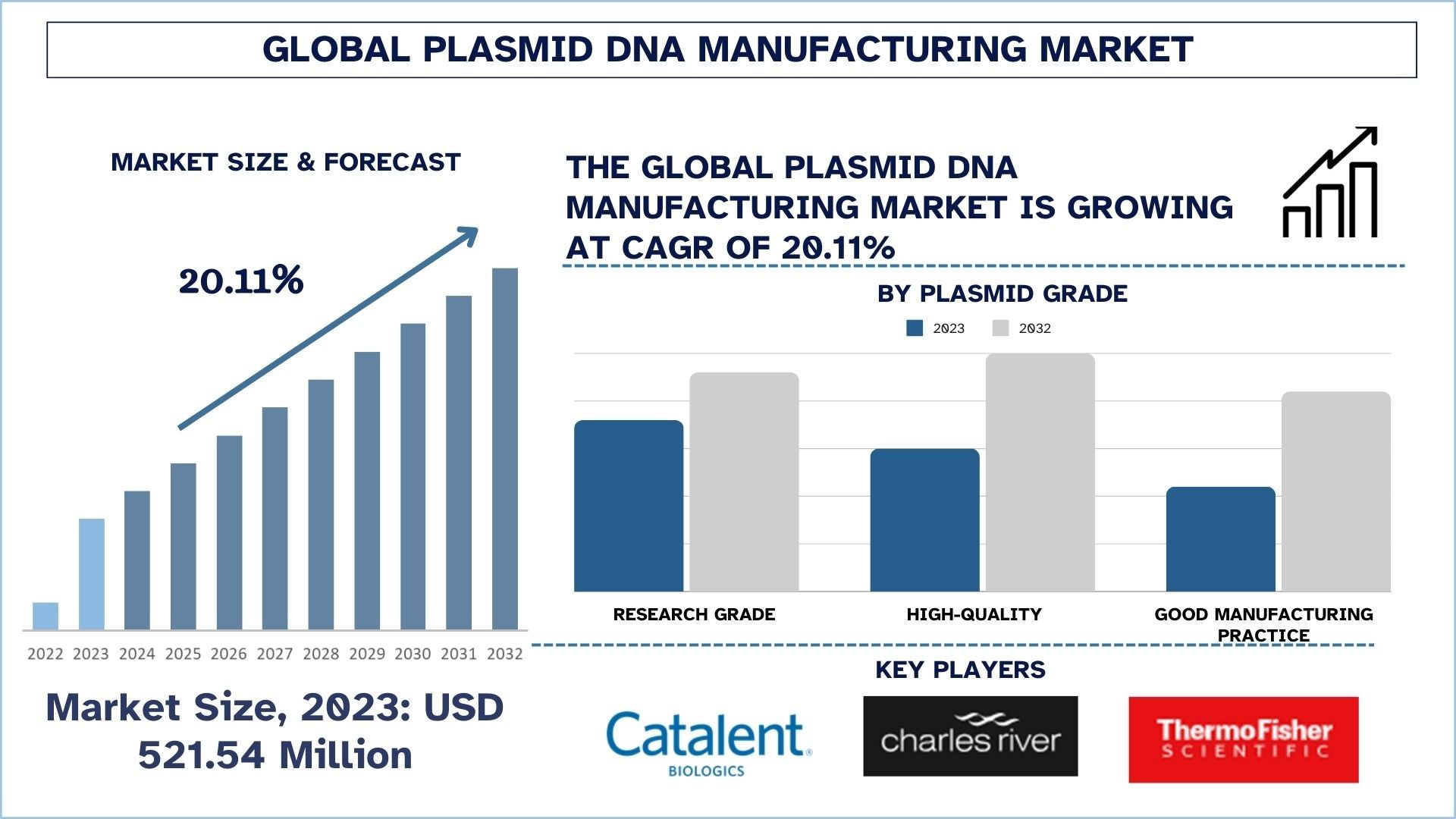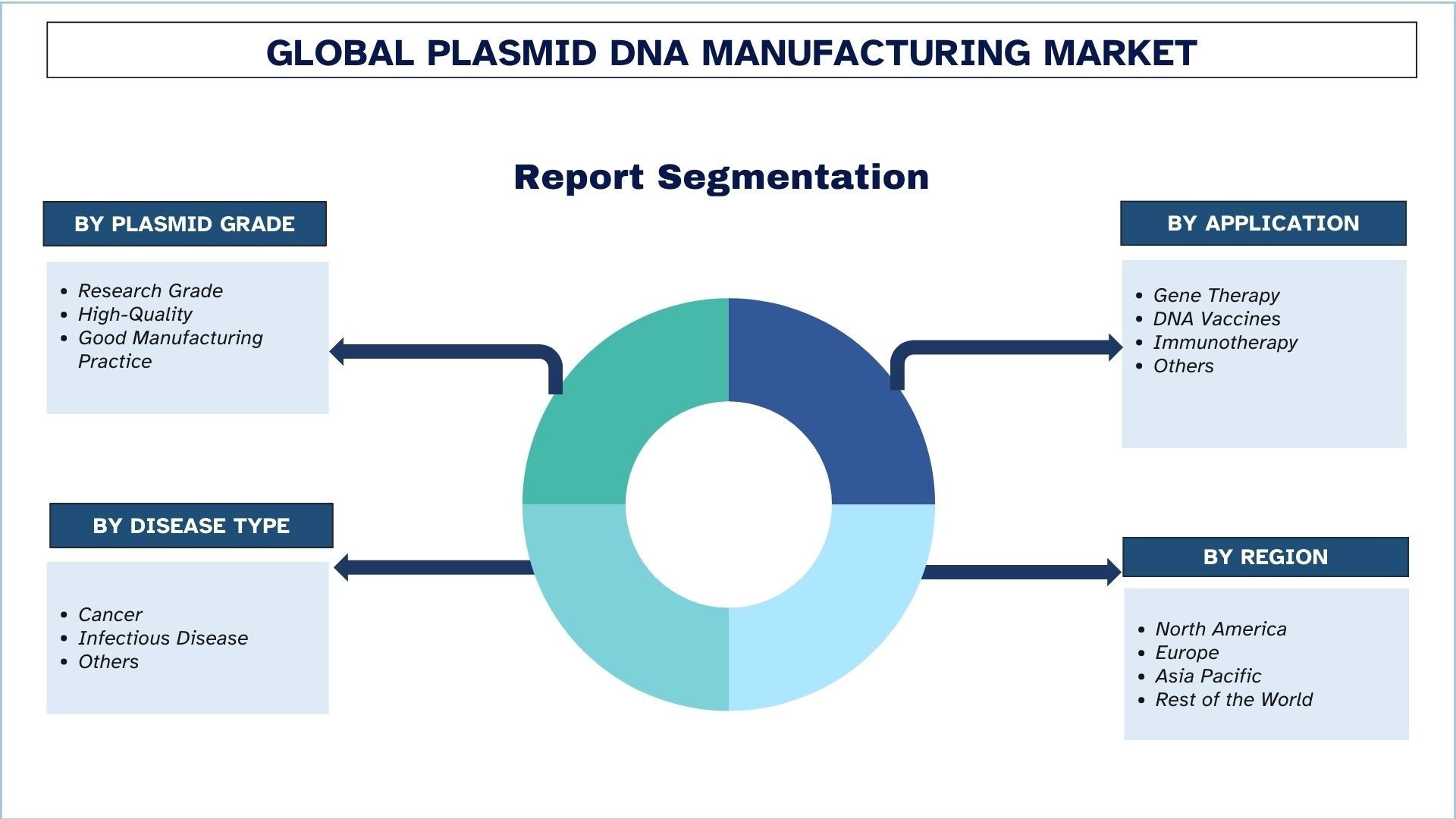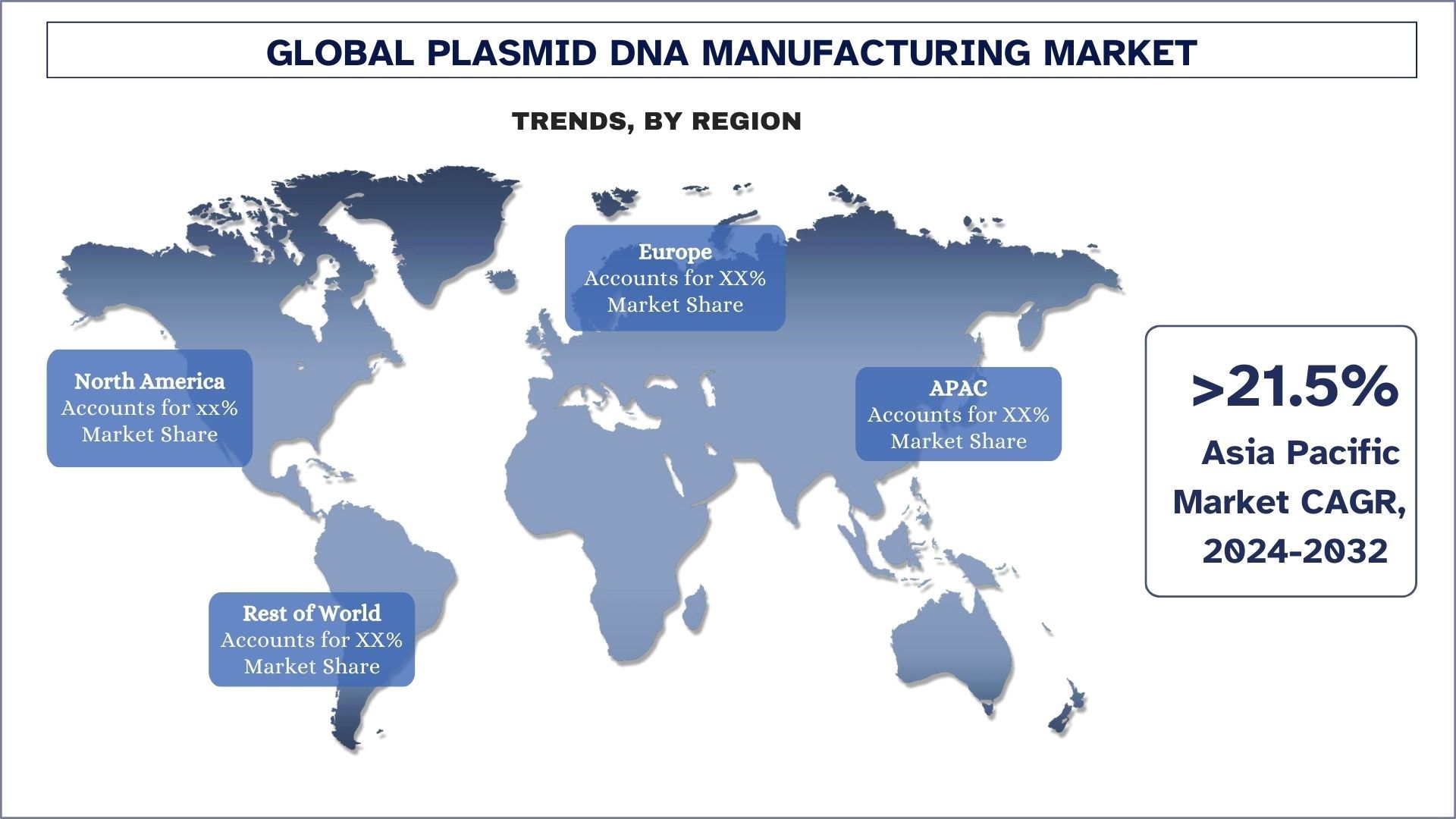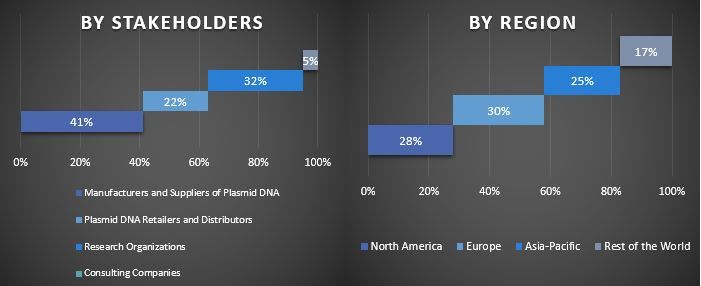
플라스미드 DNA 제조 시장 규모 및 예측
플라스미드 DNA 제조 시장은 2023년에 약 5억 2,154만 달러로 평가되었으며, 유전자 치료에 대한 수요 증가와 생명 공학의 발전으로 인해 예측 기간(2024-2032) 동안 약 20.11%의 상당한 연평균 성장률(CAGR)로 성장할 것으로 예상됩니다.
플라스미드 DNA 제조 시장 분석
플라스미드 DNA는 박테리아 및 효모를 포함한 기타 미생물에 존재하는 작고 원형의 이중 나선 구조의 DNA 분자로 설명됩니다. 염색체 DNA와 달리 플라스미드는 세포 내에서 복제할 수 있으며 세포에 특정 이점(예: 항생제에 대한 내성을 부여하는 유전자)을 제공할 수 있는 유전자를 포함합니다. 이러한 플라스미드는 수천 염기쌍만큼 작거나 수만 염기쌍만큼 클 수 있습니다. 이들은 주로 분자 생물학 및 유전 공학에서 사용되며, 연구자들은 특정 유전자를 조작하여 플라스미드에 넣어 클로닝, 유전자 발현 또는 단백질 합성을 위한 재조합 DNA를 형성합니다.
암 및 전염병의 유병률 증가, 제약 회사의 지속적인 연구 개발, 제조업체의 역량과 점유율을 높여 플라스미드 DNA 제조 치료제의 암, HIV 및 기타 만성 염증성 질환 개발을 향상시킬 수 있는 새로운 발전과 기술에 대한 지식을 높이기 위한 인수 합병 활동 증가. 또한 규제 기관의 지원이 증가함에 따라 플라스미드 DNA 제조 시장의 상당한 성장에 더욱 도움이 되고 있습니다.
플라스미드 DNA 제조 시장 동향
이 섹션에서는 당사의 연구 전문가가 확인한 바와 같이 플라스미드 DNA 제조 시장의 다양한 부문에 영향을 미치는 주요 시장 동향에 대해 논의합니다.
맞춤형 의학으로의 전환
플라스미드 DNA 제조 시장의 특징을 나타내는 주요 동향은 맞춤형 의학 시대로의 지속적인 전환입니다. 의료가 환자 특성에서 비롯된 환자의 필요에 따라 치료법을 적용하려고 노력함에 따라 전문 치료법이 등장하기 시작했습니다. 중요한 것은 플라스미드 DNA가 환자의 필요에 맞는 유전 물질의 전달 도구로 사용될 수 있기 때문에 이러한 진화에 필수적인 부분입니다. 이는 특히 질병을 유발하는 특정 유전적 변이를 목표로 하는 치료법이 있는 유전자 치료와 같은 분야에서 그렇습니다. 맞춤형 의학은 개인의 유전적 차이를 정확하게 식별할 수 있는 기술 발전에 기반을 두고 있습니다. 게놈 분석에 의한 새로운 치료 표적의 개발은 특정 유전자 또는 RNA 서열을 효율적으로 전달할 수 있는 양질의 플라스미드 DNA도 요구합니다. 이러한 수요는 기업이 다양한 응용 분야에 맞는 다양한 플라스미드 구조를 처리할 수 있는 다용도 생산 시스템을 모색함에 따라 제조 산업에 압력을 가하고 있습니다. 많은 회사들이 맞춤형 의학에 혁신을 가져오기 위해 파트너십을 늘렸습니다.
예를 들어, 2020년에 Ziopharm Oncology, Inc.는 Aldevron과 협력하여 고형 종양 치료를 위해 TCR을 발현하는 Ziopharm의 Sleeping Beauty 구조체를 위한 신속한 neoGMP® 플라스미드 DNA 제조를 확보했습니다.

북미는 2023년에 시장의 상당한 점유율을 차지합니다.
북미 플라스미드 DNA 제조는 세계 최고의 시장 중 하나입니다. 이러한 성장은 특히 전 세계적으로 점점 더 우세해지고 있는 질병에 대한 유전자 치료, 유전자 백신, 더 나은 고급 의료 치료에 대한 필요성이 증가한 결과입니다. 생명공학에 대한 중요한 투자와 적절한 의료 서비스에 대한 접근성이 적절한 자격을 갖춘 인구로 북미는 엄청난 성장을 보여주고 있습니다. 또한 시장 이해관계자와 대학 간의 인상적인 파트너십은 플라스미드 기반 치료법 및 백신에 혁신을 더욱 촉진하는 데 도움이 되고 있습니다.

플라스미드 DNA 제조 시장 개요
플라스미드 DNA 제조 시장은 여러 글로벌 및 국제 플레이어와 함께 경쟁이 치열합니다. 주요 플레이어는 파트너십, 계약, 협업, 신제품 출시, 지리적 확장, 인수 합병과 같은 다양한 성장 전략을 채택하여 시장 입지를 강화하고 있습니다. 시장에서 활동하는 주요 플레이어로는 Charles River Laboratories International, Inc., VGXI, Inc.(GeneOne Life Science), Catalent Inc.(Novo Holdings), Akron Biotech., PlasmidFactory GmbH, DH Life Sciences, LLC, Thermo Fisher Scientific Inc., Lonza, Merck KGaA, GenScript Biotech Corporation이 있습니다.
플라스미드 DNA 제조 시장 뉴스
2024년 10월 -진원생명과학은 미국의 바이오 회사와 270만 달러 규모의 플라스미드 DNA 의약품 공급 계약을 체결했다고 발표했습니다. 이 투자는 진원생명과학의 플라스미드 DNA 제품 포트폴리오를 강화할 것으로 예상됩니다.
2023년 8월 -Charles River Laboratories International, Inc.는 Fondazione Telethon과의 고품질(HQ) 플라스미드 제조 협력을 발표했습니다. 희귀 질환 기관은 Charles River의 시장을 선도하는 세포 및 유전자 계약 개발 및 제조 조직(CDMO)의 고품질(HQ) 플라스미드 DNA 생산 및 우수 제조 관리 기준(GMP) 준수 플라스미드 DNA 배치에 대한 전문 지식을 활용하여 Fondazione Telethon의 렌티바이러스 생산을 위한 HQ 플라스미드 DNA를 제조할 예정입니다. 이는 생체 외 세포 및 유전자 치료에 사용될 것입니다.
2023년 2월 -BioNTech SE는 독일 마르부르크에 회사 최초의 독점 플라스미드 DNA 제조 시설 건설 완료를 발표했습니다. 새로운 시설을 통해 BioNTech는 암 및 전염병 분야에서 임상 제품 후보 및 유전자 치료 제품을 위한 플라스미드 DNA를 독립적으로 제조할 계획입니다. 이 투자는 회사의 글로벌 입지를 확장할 것으로 예상됩니다.
플라스미드 DNA 제조 시장 보고서 범위
보고서 속성 | 세부 정보 |
기준 연도 | 2023 |
예측 기간 | 2024-2032 |
성장 모멘텀 | 연평균 성장률 20.11%로 가속화 |
2023년 시장 규모 | 5억 2,154만 달러 |
지역 분석 | 북미, 유럽, 아시아 태평양, 기타 세계 |
주요 기여 지역 | 아시아 태평양은 예측 기간 동안 가장 높은 연평균 성장률로 성장할 것으로 예상됩니다. |
주요 포함 국가 | 미국, 캐나다, 독일, 프랑스, 영국, 스페인, 이탈리아, 중국, 일본, 인도 |
프로필된 회사 | Charles River Laboratories International, Inc., VGXI, Inc.(GeneOne Life Science), Catalent Inc.(Novo Holdings), Akron Biotech., PlasmidFactory GmbH, DH Life Sciences, LLC, Thermo Fisher Scientific Inc., Lonza, Merck KGaA, GenScript Biotech Corporation. |
보고서 범위 | 시장 동향, 동인 및 제약; 수익 추정 및 예측; 세분화 분석; 수요 및 공급 측면 분석; 경쟁 구도; 회사 프로필 |
다루는 세그먼트 | 플라스미드 등급별, 응용 분야별, 질병 유형별, 지역/국가별 |
이 보고서를 구매해야 하는 이유:
이 연구에는 인증된 주요 산업 전문가가 검증한 시장 규모 측정 및 예측 분석이 포함되어 있습니다.
이 보고서는 전체 산업 성과에 대한 빠른 검토를 한눈에 제공합니다.
이 보고서는 주요 비즈니스 재무, 제품 포트폴리오, 확장 전략 및 최근 개발에 대한 주요 초점과 함께 저명한 산업 동료에 대한 심층 분석을 다룹니다.
산업에 만연한 동인, 제약, 주요 동향 및 기회에 대한 자세한 검토.
이 연구는 다양한 부문에 걸쳐 시장을 포괄적으로 다룹니다.
산업에 대한 심층적인 지역 수준 분석.
맞춤 설정 옵션:
글로벌 플라스미드 DNA 제조 시장은 요구 사항 또는 기타 시장 부문에 따라 추가로 맞춤 설정할 수 있습니다. 이 외에도 UMI는 귀하가 자신의 비즈니스 요구 사항을 가질 수 있음을 이해하므로 귀하의 요구 사항에 완전히 맞는 보고서를 얻으려면 언제든지 저희에게 연락하십시오.
목차
플라스미드 DNA 제조 시장 분석(2022-2032)을 위한 연구 방법론
전 세계 플라스미드 DNA 제조 시장의 역사적 시장 분석, 현재 시장 추정, 미래 시장 예측은 주요 지역에서 플라스미드 DNA 제조의 침투율을 분석하고 파악하기 위해 수행된 세 가지 주요 단계였습니다. 과거 시장 수치를 수집하고 현재 시장 규모를 추정하기 위해 광범위한 2차 연구가 수행되었습니다. 둘째, 이러한 통찰력을 검증하기 위해 수많은 조사 결과와 가정을 고려했습니다. 또한 전 세계 플라스미드 DNA 제조 시장의 가치 사슬 전반에 걸쳐 업계 전문가들과 심층적인 1차 인터뷰도 진행했습니다. 1차 인터뷰를 통해 시장 수치를 가정하고 검증한 후, 전체 시장 규모를 예측하기 위해 하향식/상향식 접근 방식을 사용했습니다. 이후 시장 세분화 및 데이터 삼각 측량 방법을 채택하여 산업의 세그먼트 및 하위 세그먼트의 시장 규모를 추정하고 분석했습니다. 자세한 방법론은 아래에 설명되어 있습니다.
역사적 시장 규모 분석
1단계: 2차 출처 심층 연구:
연례 보고서 및 재무 제표, 실적 발표, 보도 자료 등 회사 내부 출처와 저널, 뉴스 및 기사, 정부 간행물, 경쟁사 간행물, 부문 보고서, 제3자 데이터베이스 및 기타 신뢰할 수 있는 간행물을 포함한 외부 출처를 통해 플라스미드 DNA 제조 시장의 과거 시장 규모를 확보하기 위해 상세한 2차 연구가 수행되었습니다.
2단계: 시장 세분화:
플라스미드 DNA 제조 시장의 과거 시장 규모를 확보한 후 주요 지역의 다양한 세그먼트 및 하위 세그먼트에 대한 과거 시장 통찰력과 점유율을 수집하기 위해 상세한 2차 분석을 수행했습니다. 주요 세그먼트는 플라스미드 등급, 응용 분야, 질병 유형 및 지역으로 보고서에 포함됩니다. 해당 지역에서 플라스미드 DNA 제조의 전반적인 채택을 평가하기 위해 추가적으로 국가 수준 분석을 수행했습니다.
3단계: 요인 분석:
다양한 세그먼트 및 하위 세그먼트의 과거 시장 규모를 확보한 후 플라스미드 DNA 제조 시장의 현재 시장 규모를 추정하기 위해 상세한 요인 분석을 수행했습니다. 또한 플라스미드 DNA 제조 시장의 플라스미드 등급, 응용 분야, 질병 유형 및 지역과 같은 종속 변수 및 독립 변수를 사용하여 요인 분석을 수행했습니다. 전 세계 플라스미드 DNA 제조 시장에서 상위 파트너십, 합병 및 인수, 사업 확장 및 제품 출시를 고려하여 수요 및 공급 측면 시나리오에 대한 철저한 분석을 수행했습니다.
현재 시장 규모 추정 및 예측
현재 시장 규모 산정: 위 3단계의 실행 가능한 통찰력을 바탕으로 현재 시장 규모, 전 세계 플라스미드 DNA 제조 시장의 주요 업체 및 세그먼트의 시장 점유율을 도출했습니다. 필요한 모든 백분율 점유율 분할 및 시장 세분화는 위에서 언급한 2차 접근 방식을 사용하여 결정되었으며 1차 인터뷰를 통해 검증되었습니다.
추정 및 예측: 시장 추정 및 예측을 위해 동인 및 추세, 제약 조건 및 이해 관계자가 사용할 수 있는 기회를 포함한 다양한 요인에 가중치를 부여했습니다. 이러한 요인을 분석한 후 관련 예측 기술(즉, 하향식/상향식 접근 방식)을 적용하여 전 세계 주요 시장에서 다양한 세그먼트 및 하위 세그먼트에 대한 2032년 시장 예측을 도출했습니다. 시장 규모를 추정하기 위해 채택된 연구 방법론은 다음을 포함합니다.
매출(USD) 측면에서 업계의 시장 규모와 국내 주요 시장에서 플라스미드 DNA 제조 시장의 채택률.
시장 세그먼트 및 하위 세그먼트의 모든 백분율 점유율, 분할 및 세분화.
제공되는 제품 측면에서 전 세계 플라스미드 DNA 제조 시장의 주요 업체. 또한 빠르게 성장하는 시장에서 경쟁하기 위해 이러한 업체가 채택한 성장 전략.
시장 규모 및 점유율 검증
1차 연구: 주요 지역에서 최고 경영진(CXO/VP, 영업 책임자, 마케팅 책임자, 운영 책임자, 지역 책임자, 국가 책임자 등)을 포함한 KOL(Key Opinion Leader)과 심층 인터뷰를 진행했습니다. 그런 다음 1차 연구 결과를 요약하고 명시된 가설을 입증하기 위해 통계 분석을 수행했습니다. 1차 연구의 입력은 2차 결과와 통합되어 정보를 실행 가능한 통찰력으로 전환했습니다.
다양한 지역의 1차 참가자 분할
시장 엔지니어링
전체 시장 추정을 완료하고 전 세계 플라스미드 DNA 제조 시장의 각 세그먼트 및 하위 세그먼트에 대한 정확한 통계 수치를 도출하기 위해 데이터 삼각 측량 기술을 사용했습니다. 전 세계 플라스미드 DNA 제조 시장의 플라스미드 등급, 응용 분야, 질병 유형 및 지역의 다양한 매개변수와 추세를 연구한 후 데이터를 여러 세그먼트와 하위 세그먼트로 분할했습니다.
글로벌 플라스미드 DNA 제조 시장 연구의 주요 목표
글로벌 플라스미드 DNA 제조 시장의 현재 및 미래 시장 동향이 연구에서 정확히 지적되었습니다. 투자자는 연구에서 수행된 질적 및 양적 분석에 대한 재량 투자를 기반으로 전략적 통찰력을 얻을 수 있습니다. 현재 및 미래 시장 동향은 지역 수준에서 시장의 전반적인 매력도를 결정하여 산업 참가자가 미개척 시장을 활용하여 선점자 이점을 얻을 수 있는 플랫폼을 제공했습니다. 연구의 다른 양적 목표는 다음과 같습니다.
가치(USD) 측면에서 플라스미드 DNA 제조 시장의 현재 및 예측 시장 규모를 분석합니다. 또한 다양한 세그먼트 및 하위 세그먼트의 현재 및 예측 시장 규모를 분석합니다.
연구의 세그먼트에는 플라스미드 등급, 응용 분야, 질병 유형 및 지역 영역이 포함됩니다.
플라스미드 DNA 제조에 대한 규제 프레임워크를 정의하고 분석합니다.
다양한 중개업체의 존재와 관련된 가치 사슬을 분석하고 산업의 고객 및 경쟁자 행동을 분석합니다.
주요 지역에 대한 플라스미드 DNA 제조 시장의 현재 및 예측 시장 규모를 분석합니다.
보고서에서 연구된 지역의 주요 국가에는 아시아 태평양, 유럽, 북미 및 기타 지역이 포함됩니다.
빠르게 성장하는 시장을 유지하기 위해 시장 플레이어가 채택한 플라스미드 DNA 제조 시장 및 성장 전략의 회사 프로필.
산업에 대한 심층적인 지역 수준 분석.
자주 묻는 질문 자주 묻는 질문
Q1: 플라스미드 DNA 제조 시장의 현재 규모와 성장 잠재력은 어떻게 되나요?
플라스미드 DNA 제조 시장은 2023년에 5억 2,154만 달러로 평가되었으며 예측 기간(2024-2032) 동안 연평균 성장률(CAGR) 20.11%로 성장할 것으로 예상됩니다.
Q2: 플라스미드 DNA 제조 시장 성장의 주요 동인은 무엇입니까?
암 및 감염성 질환 발생률 증가, 약물 전달 기술 혁신, 병용 요법 개발, 지원적인 규제 체계, 연구 개발 증대가 플라스미드 DNA 제조 시장을 견인합니다.
Q3: 플라스미드 등급별 플라스미드 DNA 제조 시장에서 가장 큰 점유율을 차지하는 부문은 무엇입니까?
우수 의약품 제조 및 품질 관리 기준(GMP) 플라스미드 등급 부문이 플라스미드 등급별 플라스미드 DNA 제조 시장에서 가장 큰 점유율을 차지하고 있습니다.
Q4: 플라스미드 DNA 제조 시장의 주요 트렌드는 무엇입니까?
개인 맞춤형 의약품으로의 전환과 mRNA 백신의 성장은 플라스미드 DNA 제조 시장의 주요 트렌드입니다.
Q5: 어느 지역이 플라스미드 DNA 제조 시장을 지배할까요?
2023년에는 북미가 시장을 장악했습니다.
관련 보고서
이 상품을 구매한 고객님들도 함께 구매하신 상품











